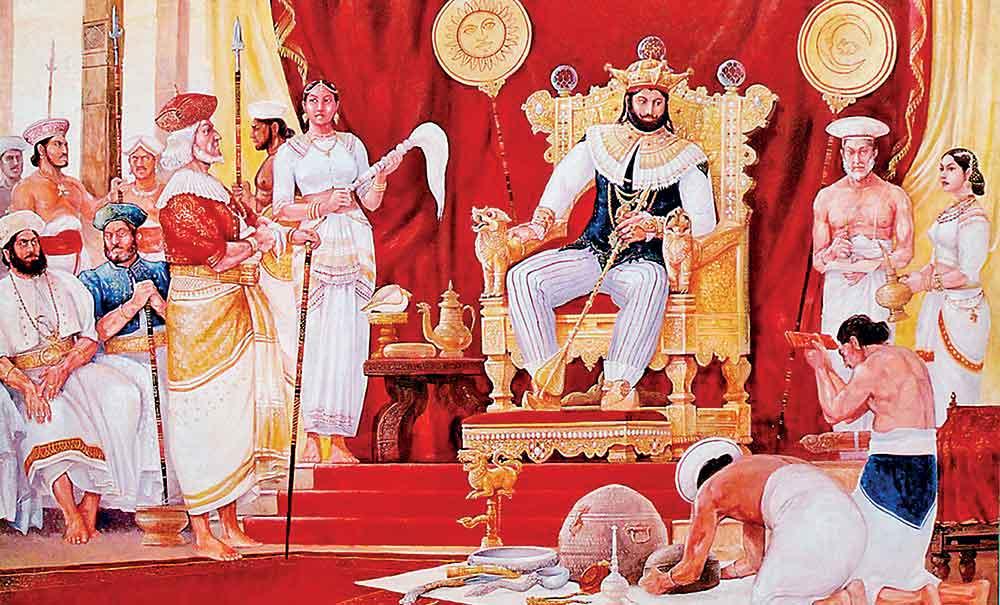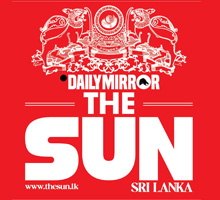
When we think of kingship in premodern Lanka, it is tempting to imagine solitary monarchs, relics at their side, issuing decrees from lotus-strewn palaces or riding elephants into war. Yet behind the aura of sovereign singularity stood an institution far more intricate, the royal court. It was not merely a place, but a structure of relations: a stage upon which power was performed, legitimated, and contested through ritual, protocol, and proximity.
The court, in its classical form, comprised ministers, generals, royal scribes, queens, ritual specialists, guards, dancers, spies, and mendicants. It was, in the phrase of historian S. Pathmanathan, “a miniature polity” in itself; a concentrated microcosm of the kingdom’s ambitions, fears, and modes of governance.The following account seeks to illuminate the court’s constituent roles and functions, culminating in a portrait of its most elaborated expression: the court of Parakramabahu I of Polonnaruwa (r. 1153–1186), whose reign offers a singular window into the aesthetic and administrative choreography of Lankan kingship.
The Court as Structure and Idea
The royal court of medieval Sri Lanka, particularly during the Anuradhapura and Polonnaruwa periods, was not a static bureaucratic institution but a flexible organism. It adapted to dynastic needs, military pressures, and ritual demands. While the Sanskrit term rajya denoted rule itself, it was through the court (pura-maṇḍala) that rule was enacted in daily life.
The court had a dual purpose: practical and performative. On the one hand, it functioned as the administrative nerve-centre of the kingdom: orders were issued, taxes levied, foreign emissaries received, and justice dispensed. On the other, it served as a site of spectacle: of procession, gift-giving, coronation, and celestial mimicry. The king was not only to govern, but to be seen governing; to embody the cosmic balance his kingdom claimed to uphold.
Figures of the Court: Offices, Obligations, and Embodied Hierarchies
The medieval royal court of Sri Lanka was not merely a constellation of titled positions; it was a finely stratified organism, animated by protocol and preserved by repetition. Within its ceremonial logic, each individual, whether minister or minstrel, carried both symbolic and practical weight. To understand the court is not only to list its members but to comprehend the performative grammar by which they were arranged, ranked, and made to signify.
At the apex stood the Mahā-Amaṭya, or Chief Minister, often a member of the nobility, though occasionally elevated from the administrative or monastic elite. He served as the sovereign’s right hand in both deliberation and decree, presiding over tax distribution, foreign treaties, judicial reviews, and temple finances. His presence was never ornamental. He signed land grants, presided over inter-provincial disputes, and sometimes even led regencies in the king’s absence. As recorded in the Galpotha Inscription of Parakramabahu I, it was the Mahā-Amaṭya who “caused to be measured the extent of the harvest” and “oversaw the quelling of unrest in Ruhuna.”
Adjacent in rank was the Senāpati, Commander of the Armed Forces. He was not merely a military officer but often a landed noble commanding regional allegiance. In wartime, he marshalled elephants, cavalry, and infantry; in peacetime, he supervised border fortresses, militias, and royal arsenals. The Cūḷavaṃsa (Ch. 75) recounts how Parakramabahu’s Senāpati was dispatched to the western seaboard to “pacify the ports” following unrest among mercantile guilds. His strategic purview extended beyond the battlefield, encompassing surveillance, diplomacy, and logistical preparation.

Then came the Pariveṇa-Mahātheras, abbots and senior monks who sat at court not as passive recipients of royal largesse, but as ritual adjudicators and spiritual consultants. Their advice was sought in calendrical matters, coronations, and relic-processions. Their presence sanctified the court’s authority. They composed and censored edicts, supervised merit-making projects, and, in some cases, intervened in succession disputes. The king ruled under their auspices; their assent, though rarely recorded, was politically indispensable.
The Queens and Consorts constituted a subtler, more veiled domain of influence. Their primary residence [the antapuraor inner palace] was a guarded space, seldom mentioned in edicts but central to the ritual and dynastic life of the monarchy. Chief queens held titles such as Agra-Mahēśī (First Queen) and occasionally issued land grants in their own name. The 11th-century Maduru Oya copper plate grants mention a royal consort endowing a vihāra with elephants and land; a rare but significant attestation of female agency within monastic patronage networks.
Lesser wives, ladies-in-waiting, and chamber attendants formed the palatial substrata, engaged in daily ritual service, custodianship of heirlooms, and the unseen rhythms of regal domesticity. Their duties included perfuming garments, preparing betel trays, and arranging offerings.
Then came the scribe-secretaries, known as lekhaka or lipikara, who functioned as both recorders and transmitters of power. They did not merely document royal commands, rather they crafted their language, structured their symbolism, and embedded them in the precedents of prior dynasties. Their ink, drawn from soot and gallnut, inscribed not only law but memory. These men were often fluent in both Sinhala and Pāli and served as mediators between oral court proceedings and the literary architecture of royal legitimacy.
The royal court of medieval Sri Lanka, particularly during the Anuradhapura and Polonnaruwa periods, was not a static bureaucratic institution but a flexible organism
An overlooked but essential part of court life were the messengers (dūta) and informants (anubodhaka); agents whose duty it was to carry decrees, gather intelligence, and report on distant provinces or foreign courts. Some were monks in appearance but emissaries in fact; others were merchants or astrologers doubling as observers. Inscriptions from the time of Nissanka Malla suggest a network of such figures dispatched to South Indian courts and even to Suvarṇabhūmi (possibly Lower Burma or the Malay Peninsula), gathering news of military and religious developments.
And finally, there were the artisans of spectacle; musicians, dancers, parasol-bearers, and bodyguards, not merely ornamental, but integral to the court’s self-image. Their movements, instruments, and apparel were regulated by court protocol, itself a kind of performative law. The presence of a certain drum, or the colour of a procession’s canopy, signified specific statuses and intentions. To enter the royal hall with the wrong emblem was not a fashion error, rather it was a violation of political code.
Each of these roles, while functionally distinct, was entangled in a ritual economy of presence. Rank was measured not only by decree but by distance from the sovereign, the privilege to speak first, or to remain standing while others knelt. The court was thus a spatialised hierarchy, where bodies signified their office by posture and position as much as by title. To walk its corridors was to read a human scroll of power, annotated daily by ritual, conversation, and the unrecorded theatre of glances and silences.
A Day in the Court of Parakramabahu I: The Polonnaruwa Zenith
To witness the court in its most elaborate form, one must turn to the reign of Parakramabahu I, whose court at Polonnaruwa (c. 1160s) stands unrivalled in Lankan memory for its organisation, scale, and theatricality.
Let us imagine an audience day at the king’s Royal Palace of Vijayantha, its multi-tiered roofs catching the light over the granite walls of the city. The sun has passed its meridian, and the flag of the lion [emblem of royal justice] has been hoisted.
Within the great audience hall, lined with stone pillars still visible today, stand rows of court officials in gilded robes. The Mahā-Amaṭya, wise and silver-bearded, reads the daily petitions. Behind him, the court scribes dip their quills into black myrobalan ink, preparing to inscribe a new edict on palm leaf.
At the periphery, clad in polished armour and sashes, the Senāpati receives orders regarding the fortifications at Mahatittha, recently reinforced against South Indian naval raids. Near him stands a monastic emissary from the Jetavanārāma, bearing a relic for temporary enshrinement, its public display coordinated with the king’s lunar astrologers. Among the courtiers, a Tamil chieftain from the south, invited in parley, offers tribute in the form of sapphires and dried areca nut, his tone deferential but his eyes sharply observant. The king listens, flanked not by his consorts, who remain in the antapura, but by attendants bearing flywhisks, fans, and ceremonial umbrellas. From behind a beaded curtain, the sound of drums and conch shells signals the beginning of the relic procession that will exit the city at twilight.
The court does not conclude with decree; it fades into ritual. Later that evening, beneath oil lamps and hanging garlands, Parakramabahu will meet with his chronicler-monk, dictating verses for the next chapter of the Cūḷavaṃsa. And so, governance blends into memory, and the day’s enactments are already being woven into the fabric of dynasty.
Conclusion: The Court as Mirror and Engine
The royal court of Lanka was not merely a functionary apparatus. It was the mirror of the state’s self-conception. Through its rituals, its ranks, its architecture and poetics, it performed the idea of a harmonious and hierarchical world, centred on the king, radiating outward through ministers, scribes, queens, relics, and dancers. It was a world where proximity to the throne conferred spiritual and political charge; where silence, standing, or the holding of a torch could encode status more clearly than parchment. And above all, it was a world that remade itself each day, through the choreography of rule. In understanding the court, we do not simply recover who governed, contrarily we understand how power was made visible, desirable, and sacred.











